Fatima Issues
 |
 |
 |
 |
 |
 |
 |
Card. Burke’s Address on Fatima – II
Fatima Intertwined with New Evangelization
TIA Note: For the convenience of our readers we broke an article by Mrs. Cornelia Ferreira titled “Fatima through the Lens of Vatican II: As Illustrated by Raymond Cardinal Burke” into a series of three smaller articles. Her piece is a lucid analysis of Card. Burke's speech about Fatima on May 19, 2017.
The titles of these three articles were chosen by TIA’s editor. A few words of transition at the end and beginning of the articles were duly added to the original written text. A.S.G.
In my last article I analyzed how Card. Burke is working to cover for the disobedience of the Popes in fulfilling Our Lady's request to consecrate Russia to the Immaculate Heart of Mary. He pretends to replace the specific consecration she requested and has not been made with the false idea that Our Lady would be asking for a cycle of consecrations to be made annually or from time to time.
The titles of these three articles were chosen by TIA’s editor. A few words of transition at the end and beginning of the articles were duly added to the original written text. A.S.G.
Now, we come to another major thrust of Card. Burke’s address: Fatima is intertwined with the “new evangelization.” This dialectical claim is a serious affront to Our Lady of Fatima. Let us see why.
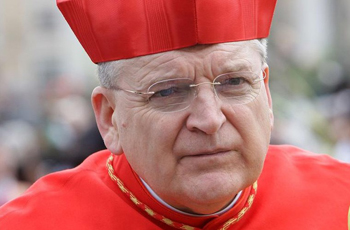
Burke praises the new evangelization of 'St John Paul II and Blessed Paul VI' linking it to Fatima
Now, before becoming Pope, Pius XII prophesied that the “persistence of [Our Lady of Fatima] about the dangers that menace the Church is a divine warning against the suicide of altering the Faith, in her liturgy, her theology and her soul … A day will come … when the Church will doubt as Peter doubted”.
This exactly describes the suicidal Council and its aftermath. For abandoning Tradition, the Church’s pastors were led into delusions and errors – what Sr. Lucia termed a “diabolical disorientation” – as a punishment of God (cf. 2 Thess 2:7-14).
Compounding their errors, the solution of “Blessed Paul VI” and “Saint John Paul II” was “a new evangelization.”
According to Card. Burke, Paul VI considered this “the fundamental form of proclaiming the truth of Christ in our time” (remember: “signs of the times”), for instance, to “intellectuals who feel the need to know Jesus Christ in a light different from the instruction they received as children.” (Paul VI, Apostolic Exhortation Evangelii nuntiandi, n. 52)
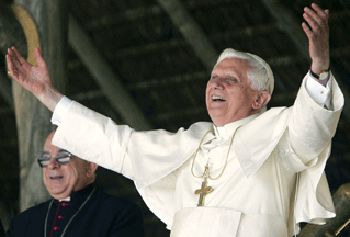
Ratzinger calls the Latin American Bishops to a new evangelization at CELAM 2007
The new evangelization is not re-evangelization, but a new way of “evangelizing.” This was made clear when, in 1985, John Paul emphasized, “The reference point for all contemporary evangelization must remain the Second Vatican Council” – not Christ’s command to teach “whatsoever I have taught you” and baptize (i.e., convert) all men into His Catholic Church, outside of which there is no salvation.
Instead, the new orientation of the Council, as proudly stated by one of its architects, Card. Ratzinger, in his book Theological Highlights of Vatican II, was non-conversion, i.e., non-evangelization. As Pope Benedict, in 2007, he reiterated this meaning of the “new evangelization” for the Latin American Bishops.
The new evangelization is opposed to conversion and salvation. New in its methodology and orientation, it is instead effecting a dialectical synthesis between traditional and modernist thinking, gradually converting Catholics to the modernist, Masonic anti-Church of Vatican II.
John Paul’s “Theology of the Body” (TOB) and World Youth Day (which would scandalize the three children of Fatima) and Francis’ Laudato si' are examples. (Incredibly, TOB is allegedly “approved” by Our Lady of Fatima and “paving the way for her triumph.”)
The new evangelization has exacerbated the disaster that dismays Card. Burke; nevertheless, in true dialectical fashion, he has re-invented Fatima to promote this fruit of Modernism. In line with the signs-of-the-times’ thirst for constant change, the Cardinal proffers the new evangelization as the goal of Our Lady of Fatima:
“Let us heed once again the maternal direction of the Virgin of Fatima for a new evangelization of the Church and, thus, of the world.”
“Reflecting upon the pressing need to respond to the grace of a new evangelization, we see how timely the apparitions and message of Our Lady of Fatima remain.”
“The words of Pope Saint John Paul II make clear the perennial importance of the Message of Fatima: the giving of one’s whole heart, together with the Immaculate Heart of Mary, to the Sacred Heart of Jesus and, thus, the commitment to become an ever more effective agent of the sorely needed new evangelization of our culture.” [Emphases added.]
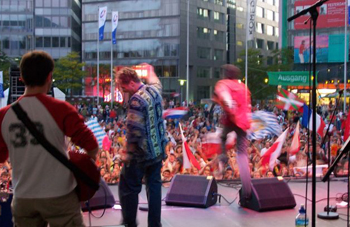
JPII's new evangelization: rock concert at the Cologne WYD; below, rocking at a Divine Mercy retreat
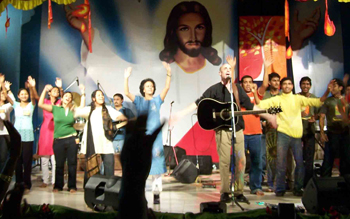
“Attention to the maternal direction of Our Lady of Fatima draw [sic] souls to Christ … for the conversion of their lives and the transformation of a culture of death into a civilization of love.”
John Paul’s mantra – “civilization of love” – recycles the Sillonist ideal condemned by Pope St. Pius X. Culture reflects religious beliefs. The only way to destroy the culture of death is to convert the whole world to the true Catholic Faith.
Card. Burke tiptoes around the First Saturdays’ devotion. He refers to the Communion of Reparation on First Saturdays without mentioning that this is to make reparation for the five blasphemies against the Immaculate Heart. Since these blasphemies are the heresies of Protestantism and other false religions, mentioning them could damage ecumenical relations; instead, Card. Burke talks vaguely of “offenses” against God. For example:
“Let us make reparation for the many and grievous offenses against the immeasurable and unceasing love of God for us by practicing the devotion of the First Saturdays. …”
This contradicts what was made clear in 1925 when the Holy Virgin appeared to Sr. Lucia with the Child Jesus, Who said: “Have compassion on the Heart of your Most Holy Mother, covered with thorns, with which ungrateful men pierce it at every moment and there is no one to make an act of reparation to remove them.”
Showing her Heart encircled with thorns, Our Lady said it was pierced by blasphemies and ingratitude. She gave Sr. Lucia the devotion of the Five First Saturdays to make reparation for these sins against her and to console her.
In 1929, when in the presence of the Holy Trinity, Our Lady requested the Consecration of Russia, she definitively stated:
“There are so many souls whom the Justice of God condemns for sins committed against me, that I have come to ask reparation: sacrifice yourself for this intention and pray.”
Furthermore, although Fatima is supposed to be about establishing devotion to the Immaculate Heart, Card. Burke’s novel emphasis throughout is on the Sacred Heart (ecumenism again?), even though devotion to the Sacred Heart had already been established through St. Margaret Mary Alacoque.
Some examples:
- “The Secret of Fatima … is fundamentally a message of hope in the victory of the Sacred Heart of Jesus through the Immaculate Heart of Mary.”
- “The victory of her Immaculate Heart which is indeed the victory of the Sacred Heart of Jesus.“
- “May the Mother of God … lead many souls to unite their hearts to her Immaculate Heart in the total consecration of their hearts to the Sacred Heart of Jesus.”
- “The Immaculate Heart of Mary will also triumph over the great darkness of our time by leading souls to the truth and love of her Divine Son, by leading souls to give their hearts, with hers, completely into the Sacred Heart of Jesus.” [Emphasis added.]
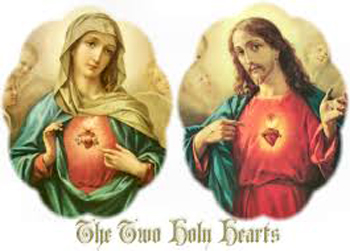
Burke mixes the Fatima message by including a consecration to the Sacred Heart
“She also foretold the terrible physical chastisements that would result from the failure to consecrate the agent of the spread of atheistic Communism to the Sacred Heart of Jesus through her Immaculate Heart and to undertake the regular practice of reparation for so many offenses communicated against the immeasurable and unceasing love of God manifested so perfectly in the glorious pierced Heart of Jesus.” [Emphases added.]
Departing from the pure message of Fatima, Card. Burke seems to be endorsing more the work of the Alliance of the Two Hearts, part of the Alliance of the Holy Family International, which operates under the Vatican’s new Dicastery for Laity, the Family and Life.
Continued

Posted June 28, 2017
______________________
______________________



